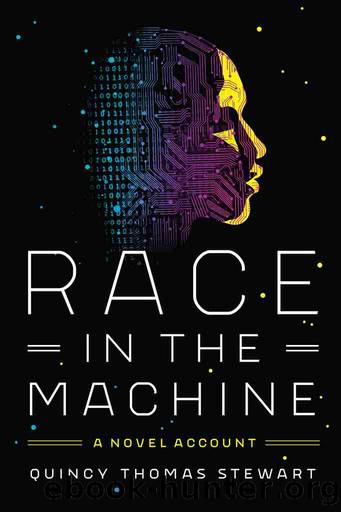Race in the Machine by Quincy Thomas Stewart

Author:Quincy Thomas Stewart
Language: eng
Format: epub
Publisher: Stanford University Press
Published: 2022-03-15T00:00:00+00:00
The aim of all this study and debate was improving well-being by applying the insight of their stories, and possibly realizing the potential of the primate herd. The challenge, though, was that monks could not see the source code. Having never observed the code, they had to learn about it by what they could see in its parts. They gathered to learn more about the code from each other, figuratively blind actors conversing about a vibrant world. This ongoing intellectual exchange led to the Great Debates.
The Great Debates began when monks from the five directions gathered to discuss the code for racial imbalance. Early on, those participating used âcutting edge scienceâ to spin wild tales about the magic behind racial imbalance. They proposed that magic was internal: it existed in the constitution of each actor in the herd. The audience, seeing the world as it was, rejoiced in knowing that magic inside justified racial imbalance.
As time passed, the Great Debates became more sophisticated. The monks developed and began to use elaborate statistical and mathematical models to describe the magic behind racial imbalance. These models, using what many still consider logical magic with the shroud of number theory, shed light on how the measured characteristics of individual actors and subgroups connected with one another. Employing these techniques, monks increasingly explored the sources of imbalance, telling extraordinary tales about the power of character, capital and many other iconic resources shaping the experience of inequality. The tales commonly concluded that changing the distribution of a resource in a certain dimension (such as general education or geography) would lead to declines in imbalance in all others. Tragically, they could not discern the key resources or who was responsible for redistributing them, individuals or the herd. This led to more studies, each looking deeper into the characteristics of individuals and subgroups, all seeking to find the source of racial imbalance.
* * *
There are such things as vampires; some of us have evidence that they exist. Even had we not proof of our own unhappy experience, the teachings and the records of the past give proof enough for sane individuals.
âBRAM STOKER, Dracula
âExtreme discrimination!â they exclaim. âThe first process that passed into awareness was a guerilla group, living on the margins, implementing a sadistic, paramilitary process, a small submachine of sorts. All of this in an effort to create a rationally soundââpronounced slowly, fully enunciated to expand the gravity of logic in this social field we shareââmore evolved, homogenous social machine.â
âI get that.â Still floating on the stream of information, I respond methodically. âHowever, I use the term to refer to the prevalence of racial antipathy . . . or, discrimination.â
An aversive impression shuttles through the interface, conveying, I initially infer, abject disappointment in either the form or direction of the reply.
âUp to this point, the simple machines depicted contexts where between 10 and 25 percent of dominant agents were discriminators for the first one-hundred encounters . . . These represent worlds where subordinate actors encounter racists between one-in-every-ten and one-in-every-four interracial encounters.
Download
This site does not store any files on its server. We only index and link to content provided by other sites. Please contact the content providers to delete copyright contents if any and email us, we'll remove relevant links or contents immediately.
Sita - Warrior of Mithila (Book 2 of the Ram Chandra Series) by Amish(54748)
The Crystal Crypt by Dick Philip K(36815)
Cat's cradle by Kurt Vonnegut(15252)
Always and Forever, Lara Jean by Jenny Han(14845)
Ready Player One by Cline Ernest(14573)
The Last by Hanna Jameson(10193)
Year One by Nora Roberts(9742)
Persepolis Rising by James S. A. Corey(9287)
The remains of the day by Kazuo Ishiguro(8887)
Never let me go by Kazuo Ishiguro(8783)
Red Rising by Pierce Brown(8679)
Dark Space: The Second Trilogy (Books 4-6) (Dark Space Trilogies Book 2) by Jasper T. Scott(8144)
The handmaid's tale by Margaret Atwood(7705)
The Circle by Dave Eggers(7063)
Frank Herbert's Dune Saga Collection: Books 1 - 6 by Frank Herbert(6997)
The Testaments by Margaret Atwood(6833)
Legacy by Ellery Kane(6616)
Pandemic (The Extinction Files Book 1) by A.G. Riddle(6485)
Six Wakes by Mur Lafferty(6198)
